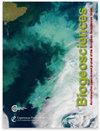珊瑚碎石的动员阈值和珊瑚礁恢复窗口期的后果
IF 3.9
2区 地球科学
Q1 ECOLOGY
引用次数: 0
摘要
摘要据预测,随着扰动强度和频率的增加,礁石上的碎石覆盖比例也会增加。不稳定的碎石会杀死新招募的珊瑚,并破坏将碎石转化为珊瑚招募的稳定基质的结合过程。要更清楚地了解珊瑚在碎石上被抑制的恢复机制,就需要描述触发碎石动员的水动力条件。在这里,我们调查了马尔代夫珊瑚礁在波浪水槽和不规则波浪条件下的正常波浪条件下的碎石动员。我们研究了近床波轨道速度的变化如何影响碎石运动(例如摇晃)和运输(通过行走,滑动或翻转)的可能性。碎石的动员被认为是碎石长度、分枝性(分枝与未分枝)和底层基质(碎石与沙子)的函数。近床波轨道速度对碎石动员的影响在水槽和珊瑚礁观测之间是相当的。随着近床波轨道速度的增加,碎石更有可能形成岩石,被运输并传播更远的距离。在长度、分枝和基材上平均,当近床波轨道速度在波浪水槽和礁石上达到0.30 m s - 1时,松散的碎石有50%的机会被搬运。然而,小的和/或未分叉的碎石块通常比大的、分叉的碎石块移动得更多,速度也更低。在由沙子组成的基质上,碎石比碎石每天移动的距离更远(约2厘米)。重要的是,如果碎石是环环相扣的,它就不太可能移动。即使在测试的最高速度(0.4 m s - 1)下,也有7%的机会。此外,在现场的3d部署中,碎石运输的可能性下降了,这表明在部署的头几天内,碎石已经堵塞或固定在更流体动力学稳定的位置。我们预计,在具有更高能量事件和更多变的波浪环境的地方,受阻或沉降的碎石更常被运输。在我们在马尔代夫的现场,我们预计绑定的恢复窗口(当碎石稳定时)主要发生在较平静的东北季风期间,当时影响环礁的波浪能量较小,波浪高度较小。我们的研究结果表明,碎石床由小碎石块和/或具有较少分支的碎石块组成,在动员事件之间更有可能具有较短的恢复(稳定性)窗口,因此是碎石稳定干预措施的良好候选者,以增强珊瑚的招募和结合。本文章由计算机程序翻译,如有差异,请以英文原文为准。
Mobilisation thresholds for coral rubble and consequences for windows of reef recovery
Abstract. The proportional cover of rubble on reefs is predicted to increase as disturbances increase in intensity and frequency. Unstable rubble can kill coral recruits and impair binding processes that transform rubble into a stable substrate for coral recruitment. A clearer understanding of the mechanisms of inhibited coral recovery on rubble requires characterisation of the hydrodynamic conditions that trigger rubble mobilisation. Here, we investigated rubble mobilisation under regular wave conditions in a wave flume and irregular wave conditions in situ on a coral reef in the Maldives. We examined how changes in near-bed wave orbital velocity influenced the likelihood of rubble motion (e.g. rocking) and transport (by walking, sliding or flipping). Rubble mobilisation was considered as a function of rubble length, branchiness (branched vs. unbranched) and underlying substrate (rubble vs. sand). The effect of near-bed wave orbital velocity on rubble mobilisation was comparable between flume and reef observations. As near-bed wave orbital velocity increased, rubble was more likely to rock, be transported and travel greater distances. Averaged across length, branchiness and substrate, loose rubble had a 50 % chance of transport when near-bed wave orbital velocities reached 0.30 m s−1 in both the wave flume and on the reef. However, small and/or unbranched rubble pieces were generally mobilised more and at lower velocities than larger, branched rubble. Rubble also travelled further distances per day (∼2 cm) on substrates composed of sand than rubble. Importantly, if rubble was interlocked, it was very unlikely to move (< 7 % chance) even at the highest velocity tested (0.4 m s−1). Furthermore, the probability of rubble transport declined over 3 d deployments in the field, suggesting rubble had snagged or settled into more hydrodynamically stable positions within the first days of deployment. We expect that snagged or settled rubble is transported more commonly in locations with higher-energy events and more variable wave environments. At our field site in the Maldives, we expect recovery windows for binding (when rubble is stable) to predominantly occur during the calmer north-eastern monsoon when wave energy impacting the atoll is less and wave heights are smaller. Our results show that rubble beds comprised of small rubble pieces and/or pieces with fewer branches are more likely to have shorter windows of recovery (stability) between mobilisation events, and thus be good candidates for rubble stabilisation interventions to enhance coral recruitment and binding.
求助全文
通过发布文献求助,成功后即可免费获取论文全文。
去求助
来源期刊

Biogeosciences
环境科学-地球科学综合
CiteScore
8.60
自引率
8.20%
发文量
258
审稿时长
4.2 months
期刊介绍:
Biogeosciences (BG) is an international scientific journal dedicated to the publication and discussion of research articles, short communications and review papers on all aspects of the interactions between the biological, chemical and physical processes in terrestrial or extraterrestrial life with the geosphere, hydrosphere and atmosphere. The objective of the journal is to cut across the boundaries of established sciences and achieve an interdisciplinary view of these interactions. Experimental, conceptual and modelling approaches are welcome.
 求助内容:
求助内容: 应助结果提醒方式:
应助结果提醒方式:


